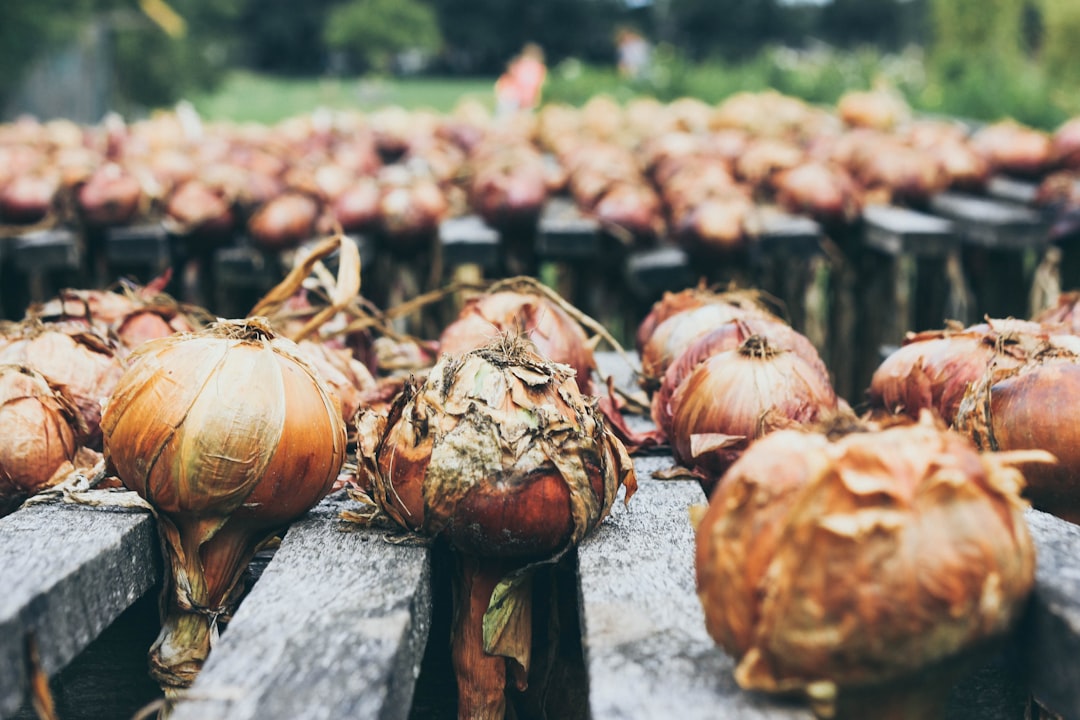Planting Onion Plants: The Right Depth

Onion plants are a staple in many kitchens around the world. They add flavor and depth to a wide variety of dishes, making them an essential ingredient in countless recipes. But have you ever considered growing your own onion plants in your garden? Not only is it a rewarding experience, but it also allows you to have a fresh supply of onions right at your fingertips.
Growing onion plants in your garden has numerous benefits. Firstly, it gives you control over the quality and freshness of the onions you consume. You can ensure that no harmful chemicals or pesticides are used in their cultivation, making them a healthier option for you and your family. Additionally, growing your own onion plants can save you money in the long run, as store-bought onions can be quite expensive. Lastly, it allows you to experiment with different onion varieties and flavors that may not be readily available in stores.
Key Takeaways
- Planting onion plants is a great way to grow your own fresh produce at home.
- Planting onion plants at the right depth is crucial for their growth and development.
- Factors such as soil type, climate, and onion variety can affect the depth at which onion plants should be planted.
- To determine the right depth for planting onion plants, measure the height of the bulb and plant it at a depth that is two to three times its height.
- Before planting onion plants, prepare the soil by removing weeds and adding compost or fertilizer.
Importance of planting onion plants at the right depth
The depth at which you plant your onion plants plays a crucial role in their growth and development. Onions have shallow root systems, so planting them at the correct depth is essential for their overall health and productivity. If planted too shallow, the roots may not establish properly, leading to weak and stunted growth. On the other hand, if planted too deep, the bulbs may not form properly or may rot due to excessive moisture.
Proper planting depth is also important for the development of the onion bulb. If planted too shallow, the bulb may not have enough room to expand and grow to its full potential. This can result in smaller bulbs or even no bulb formation at all. Conversely, if planted too deep, the bulb may have difficulty pushing through the soil surface, leading to misshapen or damaged bulbs.
Factors affecting onion plant depth
Several factors can influence the ideal planting depth for onion plants. One of the primary factors is the type and texture of the soil. Different soil types have varying levels of drainage and water-holding capacity. Sandy soils, for example, drain quickly and may require planting the onion plants slightly deeper to ensure adequate moisture. Clay soils, on the other hand, retain water for longer periods and may require planting the onion plants slightly shallower to prevent waterlogged conditions.
Climate and weather conditions also play a role in determining the planting depth of onion plants. In areas with hot and dry climates, planting the onion plants slightly deeper can help them access moisture deeper in the soil. Conversely, in areas with cooler climates or excessive rainfall, planting the onion plants slightly shallower can prevent waterlogging and rot.
The variety of onion plant being grown is another factor to consider when determining planting depth. Different varieties have different growth habits and bulb sizes. Some varieties may require deeper planting to accommodate larger bulbs, while others may require shallower planting for smaller bulbs.
How to determine the right depth for planting onion plants
| Depth (inches) | Plant Growth | Yield (lbs) |
|---|---|---|
| 1 | Shallow roots, weak plants | Low yield |
| 2 | Healthy roots, strong plants | Medium yield |
| 3 | Deep roots, sturdy plants | High yield |
Determining the right depth for planting onion plants is relatively simple and can be done using a few basic steps. Firstly, prepare the soil by removing any weeds or debris and loosening it with a garden fork or tiller. This will ensure that the soil is loose and well-drained, providing an optimal environment for root development.
Next, measure the depth at which you will be planting the onion plants. The general rule of thumb is to plant them with the tip of the bulb just below the soil surface. To measure this depth, use a ruler or gardening tool to mark the desired depth on a stake or stick. Place this stake in the ground next to where you will be planting each onion plant.
Preparing the soil for planting onion plants
Proper soil preparation is crucial for optimal onion plant growth. Onions prefer well-drained soil with a pH level between 6.0 and 7.0. Before planting, it is important to test the soil pH and make any necessary adjustments. If the soil is too acidic, adding lime can help raise the pH level. If the soil is too alkaline, adding sulfur can help lower the pH level.
In addition to pH levels, soil nutrient levels are also important for onion plant growth. Onions require a balanced supply of nutrients, including nitrogen, phosphorus, and potassium. Conducting a soil test can help determine the nutrient levels in your soil and guide you in making any necessary amendments. Adding organic matter, such as compost or well-rotted manure, can also improve soil fertility and structure.
Tips for planting onion plants at the right depth

When planting onion plants at the right depth, there are a few best practices to keep in mind. Firstly, ensure that the soil is moist but not waterlogged. This will help the roots establish quickly and prevent them from drying out. If the soil is too dry, water it thoroughly before planting.
When placing the onion plants in the ground, make sure to space them adequately to allow for proper bulb development. Onions should be planted approximately 4-6 inches apart, with rows spaced about 12-18 inches apart. Overcrowding can lead to competition for nutrients and stunted growth.
Avoid planting onion plants too deep or too shallow. As mentioned earlier, the tip of the bulb should be just below the soil surface. Planting them too deep can hinder bulb development, while planting them too shallow can result in weak root establishment.
Common mistakes to avoid when planting onion plants
When planting onion plants, there are a few common mistakes that should be avoided. One of these is overcrowding. It can be tempting to plant as many onion plants as possible in a small space, but this can lead to poor growth and smaller bulbs. Adequate spacing allows each plant to receive the necessary nutrients and sunlight for optimal growth.
Another mistake to avoid is planting onion plants too deep or too shallow. As mentioned earlier, the tip of the bulb should be just below the soil surface. Planting them too deep can hinder bulb development, while planting them too shallow can result in weak root establishment.
Lastly, failing to properly prepare the soil can also hinder onion plant growth. It is important to remove any weeds or debris and ensure that the soil is loose and well-drained. This will provide an optimal environment for root development and prevent waterlogging.
Watering and fertilizing onion plants after planting
After planting onion plants, proper watering and fertilization are essential for their continued growth and development. Onions require consistent moisture throughout their growing season, but they are also susceptible to rot if the soil becomes waterlogged. It is important to water them deeply but infrequently, allowing the soil to dry out slightly between waterings.
Fertilizing onion plants is also important for their overall health and productivity. Onions have a high nitrogen requirement, especially during the early stages of growth. Applying a balanced fertilizer with a higher nitrogen content can help promote leafy growth and bulb development. It is important to follow the manufacturer’s instructions for application rates and timing.
Monitoring onion plant growth and development
Monitoring the growth and development of onion plants is crucial for identifying any issues or deficiencies early on. Healthy onion plants should have upright, green foliage and firm bulbs. If the foliage starts to turn yellow or wilt, it may be a sign of nutrient deficiency or overwatering. Adjusting the watering and fertilization practices accordingly can help address these issues.
Pests and diseases can also affect onion plant growth. Common pests include onion maggots, thrips, and aphids. Regularly inspecting the plants for any signs of pest damage can help prevent infestations from spreading. Diseases such as onion rot and downy mildew can also impact onion plant health. Proper sanitation practices, such as removing infected plants and avoiding overhead watering, can help prevent the spread of diseases.
Harvesting onion plants and storing them properly
Harvesting onion plants at the right time is crucial for optimal flavor and storage life. Onions are typically ready for harvest when the foliage starts to turn yellow and fall over. Gently lift the bulbs from the soil using a garden fork or trowel, being careful not to damage them.
After harvesting, it is important to properly cure the onions before storage. Curing involves drying the onions in a warm, well-ventilated area for several weeks. This allows the outer layers to dry and form a protective skin, extending their storage life. Once cured, store the onions in a cool, dry place with good air circulation.
Planting onion plants at the right depth is essential for their overall health and productivity. Factors such as soil type, climate, and onion variety can influence the ideal planting depth. By following proper planting techniques, preparing the soil adequately, and monitoring the plants’ growth and development, you can ensure a bountiful harvest of healthy onions. So why not give it a try? Planting onion plants in your garden can be a rewarding experience that allows you to enjoy fresh, flavorful onions all year round.
If you’re looking for more information on how deep to plant onion plants, check out this helpful article on Lawn World’s website. They provide detailed guidance on the proper planting depth for onions, ensuring optimal growth and yield. To explore this topic further, visit their website at https://www.lawnworld.com/. You can also browse through their sitemap at https://www.lawnworld.com/sitemap.html to discover other valuable resources related to gardening and lawn care.
FAQs
What is the ideal depth for planting onion plants?
The ideal depth for planting onion plants is about 1 inch deep.
Why is it important to plant onion plants at the right depth?
Planting onion plants at the right depth ensures that the roots are properly anchored in the soil and that the plant has access to the necessary nutrients and water.
What happens if onion plants are planted too shallow?
If onion plants are planted too shallow, they may not develop strong roots and may be more susceptible to drying out or being blown over by wind.
What happens if onion plants are planted too deep?
If onion plants are planted too deep, they may struggle to emerge from the soil and may not receive enough sunlight to grow properly.
When is the best time to plant onion plants?
The best time to plant onion plants is in the early spring, as soon as the soil can be worked.
What type of soil is best for planting onion plants?
Onion plants prefer well-draining soil that is rich in organic matter. A soil pH of 6.0 to 6.8 is ideal for onion plants.
How far apart should onion plants be planted?
Onion plants should be planted about 4 to 6 inches apart, with rows spaced about 12 to 18 inches apart.



